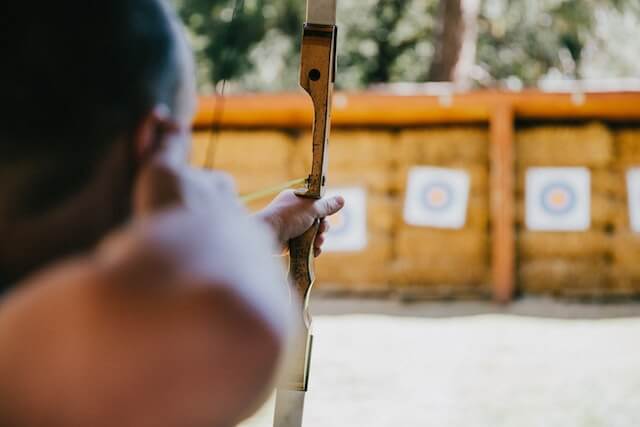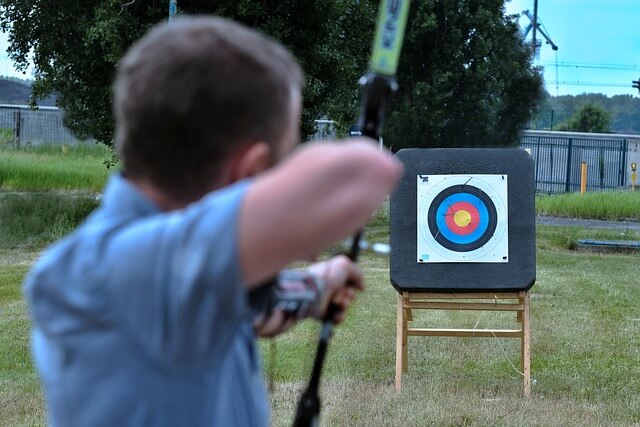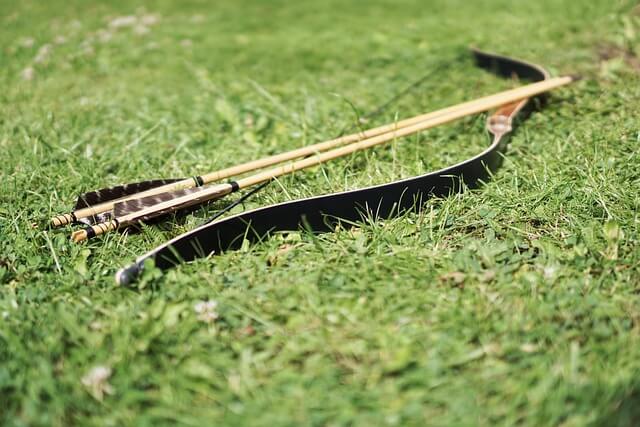Recurve Bow Archery for Beginners (Best Starter Bow)

If you’ve ever had the itch to give archery a shot, you should know you’re in for a wild ride! Here we go over recurve archery for beginners, with our top pick for the best beginner recurve bow.
Archery is a sport that connects you with history, nature, and your inner Robin Hood. But, before you start hitting bullseyes, there’s a lot to learn.
The good news is, even if you’re a complete novice, recurve bows are the best place to begin your journey!
In this comprehensive guide, we’ll take deep dive into the world of recurve bows, breaking down everything you need to know as a beginner.
{Affiliate links included below.}
Choosing the Right Bow: The Recurve’s the Curve

When it comes time to pick out your very first bow, it’s crucial to pick one that matches your skill level.
Recurve bows are definitely an excellent choice for beginners! These bows have a simple, straightforward design that’s both functional and forgiving.
Unlike compound bows—which can be complex and unforgiving—recurve bows offer a more traditional archery experience.
This makes them the perfect option for beginning archers.
Understanding the Basics: Draw Weight and Length
There are two key factors to look at when you’re choosing your first bow. These are are draw weight and draw length.
Let’s make it easy: Draw weight refers to the amount of force needed to pull back the bowstring, while draw length is the distance you pull it. Pretty simple, huh?
As a beginner, it’s essential to start with a bow that has a lower draw weight.
You’ll need to build your archery muscles gradually, and a bow with a lower draw weight will help you develop good form and avoid overexertion.
On the other hand, draw length depends on your body’s unique proportions.
To find your optimal draw length, you can consult with experienced archers, or better yet, an archery instructor.
Having the right draw length is super important for both accuracy and comfort in archery.
Different Strokes for Different Folks: What’s the Right Bow for You?

Right-handed? Left-handed? No problem—there’s a bow for you!
A right-handed bow is held in the left hand and drawn with the right, while a left-handed bow is held in the right hand and drawn with the left.
To find the right bow for you, consider your dominant hand and eye. Your dominant hand will dictate the hand you hold the bow with, and your dominant eye will help you with aiming.
Exploring a Wide Range of Draw Weights
Recurve bows come in a wide range of draw weights, making them suitable for archers of all levels.
For beginners, a lower draw weight, typically between 15-30 pounds, is ideal.
The lower draw weight is easier to handle, and you can focus on proper form and technique without straining yourself.
More experienced archers may opt for a higher draw weight for greater accuracy and kinetic energy, but that’s not recommended for novices.
A Flexible Friend: The Takedown Bow
One great thing about recurve bows is their versatility. The takedown bow, like the Samick Sage (see below), is an outstanding recurve bow for beginners.
Its modular design allows you to easily disassemble it into smaller parts, making it compact and portable.
Whether you’re on a backpacking trip or practicing in your backyard, a takedown bow is a smart choice.
Bow Accessories: Sights, Rests, and More
To help you hit the bullseye, you can accessorize your recurve bow with various add-ons.
Here are some of the most popular accessories for a recurve bow:
- A bow sight, like a peep sight or pin sight, aids in aiming.
- An arrow rest provides a stable platform for your arrow, reducing the chance of stray shots.
- Finger tabs, arm guards, and finger guards protect your digits and forearm from the bowstring’s slap.
- A bow case keeps your equipment safe during transport.
- And don’t forget the arrows—you can’t do much without those!
The Samick Sage: A Great Choice for Novice Archers

The Samick Sage takedown recurve bow is a fantastic option—and our #1 choice—for those taking their first steps in archery.
Its blend of performance, versatility, and affordability makes it a fantastic pick when you’re just getting started.
The Perfect Starting Point
The Samick Sage has earned a reputation as one of the best bows for novice archers, and for good reason!
This takedown recurve bow offers a combination of features that make it an ideal choice for beginners.
Its straightforward design and user-friendly features ensure that new archers can quickly adapt and enjoy their archery experience from the get-go.

Durability and Classic Aesthetics
One of the standout features of the Samick Sage is its wooden risers and fiberglass limbs.
The light weight Maple wooden risers provide a classic and attractive appearance, reminiscent of traditional archery.
And the fiberglass laminated limbs are tough enough to withstand repeated use.
This combination of materials not only gives the bow a timeless look but also ensures its durability.
The bow can withstand the rigors of regular practice and maintain its performance over time.
A Wide Range of Draw Weights
One of the significant advantages of the Samick Sage is its availability in a wide range of draw weights. For novice archers, this flexibility is invaluable.
You can choose a draw weight that matches your current strength and skill level. Starting with a lower draw weight (typically 25-30 pounds) is recommended, as it allows beginners to focus on proper form and technique without overexerting themselves.
As you progress in your skills, you can increase the draw weight (the Samick Sage goes up to 60 pounds).
This ensures that the bow grows with you and accommodates your developing archery skills.
Versatility with Takedown Design

The Samick Sage’s takedown design is a significant asset for novice archers.
This feature allows you to easily disassemble the bow into smaller, manageable components.
Whether you’re heading out on a backpacking trip or simply looking to practice in your backyard, the takedown design makes it highly portable and convenient.
This versatility makes the Samick Sage a great choice for those who want the flexibility to enjoy archery in various settings.
What We Love About the Samick Sage
The Samick Sage is more than just a piece of archery equipment; it’s the gateway to a rewarding archery journey.
As a beginner archer, you’ll appreciate the bow’s simplicity and user-friendliness.
You’ll also have the opportunity to develop proper form, refine your shooting technique, and improve your accuracy, all with the support of a reliable and durable piece of equipment.
Whether you’re aiming to hit bullseyes or simply enjoy the satisfying thwack of your arrows landing on target, the Samick Sage offers a fantastic starting point for your archery adventure.
With dedication, practice, and the right equipment in hand, you’ll find that this bow is not only a great choice for novice archers but also a trusted companion on your journey toward becoming a skilled and confident archer.
Go here now to learn more about the Samick Sage Takedown Recurve Bow
Finding Your Way with a Bow Set
For beginner archers, a bow package or set is a great way to get all the necessary equipment in one go.

These beginner kits typically include the bow, arrows, a bow stringer, and sometimes additional accessories like a finger tab, arm guard, and finger guard.
Sets are a convenient way to kickstart your archery journey without having to piece everything together separately.
Go here now to learn more about the Samick Sage Takedown Recurve Bow Set
Proper Form: The Foundation of Archery
Good form is the cornerstone of accurate archery. It’s like building a house; without a strong foundation, it’s bound to crumble.
When you’re at full draw, your anchor point, the spot where you hold your string, should be consistent.
Your stance, grip, and release should all be practiced regularly to maintain proper form.
Getting Started with Target Practice
Target practice is where the real fun begins when you’re shooting your new bow.
Find a good place to practice, whether it’s at an archery range or in your backyard, ensuring safety is your top priority.
As a beginner, focus on hitting the target consistently before aiming for the bullseye. It’s all about baby steps!

With practice, you’ll get better and better and soon be hitting the bullseye more consistently.
Modern vs. Traditional: Recurve Design
When you delve into the world of recurve bows, you’ll notice there are both modern and traditional options.
Traditional recurve bows have wooden risers and a more classic look, perfect for those who appreciate the historical aspect of archery.
Modern recurve bows come with metal risers and often incorporate advanced materials, making them more durable and efficient.
Both bow types are popular with archers. Take a look at the different options to see which one looks like the best pick for you.
Safety First: Brace Height Matters
Brace height is the distance between the grip and the bowstring when the bow is unstrung.
As a beginner, you don’t need to worry too much about this, as most recurve bows are designed with a safe brace height.
However, it’s essential to be aware of it to prevent damaging your bow or injuring yourself.
Draw, Release, Repeat: The Joy of Archery
Archery is all about the rhythm – drawing, releasing, and repeating. It’s a sport that requires patience and practice. There’s no need to rush; it’s about the journey, not just the destination.
As you continue to shoot archery on a regular basis, you’ll see your skills improve, and your confidence soar.
Determining Your Skill Level
Your skill level will naturally progress as you spend more time with your bow.
Don’t worry about starting at the same skill level as an experienced archer – it’s all part of the journey!
The most important thing is to enjoy yourself and keep improving at your own pace.
A Beginner’s Dream: Lightweight Bows
Lightweight bows are an excellent choice for new archers, especially older kids and young adults.
They are easy to carry and handle, making them perfect for beginners.
A lighter bow can help you focus on your form and accuracy without being weighed down.
Archery as a Sport
Archery is not just a hobby; it’s a sport that requires dedication and passion.
Just like any sport, it’s all about pushing your limits and striving to become better with every shot.
Don’t underestimate the satisfaction of hitting your target dead center – it’s a feeling of accomplishment like no other!
The Ultimate Goal: Bullseye
The bullseye is the archer’s holy grail, and hitting it feels like winning the Super Bowl.
It might take some time and effort, but with patience and practice, you’ll get there.
And remember, it’s not just about the destination; it’s about the journey.
Choosing the Right Draw Weight
Selecting the right draw weight is crucial for your archery journey.
The draw weight you choose should match your physical capabilities and experience level.
For a beginner, a lower draw weight is a better idea to start with. You can always increase it as you gain more strength and skill.

Maximum Draw Weight: A Limit to Respect
Every bow has a maximum draw weight that should not be exceeded. This limit is there for your safety and the bow’s longevity.
Exceeding the maximum draw weight can lead to injury and damage to the bow.
Always respect this limit and choose a bow that suits your strength and experience level.
The Role of the Dominant Eye
Your dominant eye plays a significant role in your accuracy.
To determine your dominant eye, extend your arms and create a small triangle with your hands, focusing on an object in the distance.
The dominant eye will align with the object, making it your dominant eye.
It’s essential to use this eye for aiming to achieve better accuracy.
Wood Riser vs. Metal Riser: The Battle of Materials
Risers, the central part of the bow, can be made from different materials.
Wood risers provide a traditional and attractive option, while metal risers offer durability and efficiency.
The choice between wood and metal risers comes down to personal preference and your archery goals.
Archery Equipment for Beginners
As a novice archer, it’s essential to have the right equipment.
Besides the bow and arrows, you’ll need accessories like a finger tab, arm guard, and finger guard to protect your hands and forearm.
A bow case is also needed to keep your equipment safe and organized.
Take your time to explore different features and choose what suits your style.
We recommend a recurve bow archery set that includes the basics you need to get started.
Recurve Archery for Beginners: A Journey Worth Taking
Embarking on your archery journey is a great way to connect with history and the great outdoors.
Whether you’re young or old, new to the sport or experienced, archery has something to offer.
Recurve bows provide an excellent entry point, with their straightforward design and suitability for beginners.
The simplicity of their design, a wide range of draw weights, and the availability of takedown models like the Samick Sage make them a fantastic option.
The journey will be full of ups and downs, but the satisfaction of hitting the bullseye makes it all worth it.










